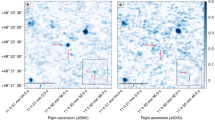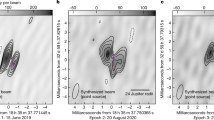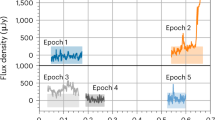Abstract
Coherent low-frequency (≲200 MHz) radio emission from stars encodes the conditions of the outer corona, mass-ejection events and space weather1,2,3,4,5. Previous low-frequency searches for radio-emitting stellar systems have lacked the sensitivity to detect the general population, instead largely focusing on targeted studies of anomalously active stars5,6,7,8,9. Here we present 19 detections of coherent radio emission associated with known M dwarfs from a blind flux-limited low-frequency survey. Our detections show that coherent radio emission is ubiquitous across the M dwarf main sequence, and that the radio luminosity is independent of known coronal and chromospheric activity indicators. While plasma emission can generate the low-frequency emission from the most chromospherically active stars of our sample1,10, the origin of the radio emission from the most quiescent sources is yet to be ascertained. Large-scale analogues of the magnetospheric processes seen in gas giant planets3,11,12 probably drive the radio emission associated with these quiescent stars. The slowest-rotating stars of this sample are candidate systems to search for star–planet interaction signatures.
This is a preview of subscription content, access via your institution
Access options
Access Nature and 54 other Nature Portfolio journals
Get Nature+, our best-value online-access subscription
$29.99 / 30 days
cancel any time
Subscribe to this journal
Receive 12 digital issues and online access to articles
$119.00 per year
only $9.92 per issue
Buy this article
- Purchase on Springer Link
- Instant access to full article PDF
Prices may be subject to local taxes which are calculated during checkout


Similar content being viewed by others
Data availability
LOFAR visibilities taken before 2020 are publicly available via the LOFAR Long Term Archive (https://lta.lofar.eu/https://lta.lofar.eu/). The XMM-Newton data on LP 212-62, G 240-45, LP 169-22, and GJ 1151 are available through the XMM-Newton Science Archive (XSA; http://nxsa.esac.esa.int/nxsa-web). All other data used in the paper have been sourced from the public domain.
Code availability
The important codes used to analyse the data are available at the following sites: WSClean (https://gitlab.com/aroffringa/wsclean) and DDF pipeline (https://github.com/mhardcastle/ddf-pipeline). This work has also made use of TOPCAT59, the IPYTHON package60; SciPy61; MATPLOTLIB, a PYTHON library for publication quality graphics62; ASTROPY, a community-developed core PYTHON package for astronomy63; and NUMPY64.
References
Dulk, G. A. Radio emission from the Sun and stars. Annu. Rev. Astron. Astrophys. 23, 169–224 (1985).
Lazio, W. et al. The radiometric Bode’s law and extrasolar planets. Astrophys. J. 612, 511–518 (2004).
Zarka, P. Plasma interactions of exoplanets with their parent star and associated radio emissions. Planet. Space Sci. 55, 598–617 (2007).
Turnpenney, S., Nichols, J. D., Wynn, G. A. & Burleigh, M. R. Exoplanet-induced radio emission from M dwarfs. Astrophys. J. 854, 72 (2018).
Villadsen, J. & Hallinan, G. Ultra-wideband detection of 22 coherent radio bursts on M dwarfs. Astrophys. J. 871, 214 (2019).
Crosley, M. K. et al. The search for signatures of transient mass loss in active stars. Astrophys. J. 830, 24 (2016).
Lenc, E., Murphy, T., Lynch, C. R., Kaplan, D. L. & Zhang, S. N. An all-sky survey of circular polarization at 200 MHz. Mon. Not. R. Astron. Soc. 478, 2835–2849 (2018).
Vedantham, H. V., Callingham, J. R., Shimwell, T. & Pope, B. J. S. Coherent radio emission from a quiescent red dwarf indicative of star-planet interaction. Nat. Astron. 4, 577–583 (2020).
Lynch, C. R., Lenc, E., Kaplan, D. L., Murphy, T. & Anderson, G. E. 154 MHz detection of faint, polarized flares from UV Ceti. Astrophys. J. Lett. 836, L30 (2017).
Güdel, M. Stellar radio astronomy: probing stellar atmospheres from protostars to giants. Annu. Rev. Astron. Astrophys. 40, 217–261 (2002).
Zarka, P., Cecconi, B. & Kurth, W. S. Jupiter’s low-frequency radio spectrum from Cassini/Radio and Plasma Wave Science (RPWS) absolute flux density measurements. J. Geophys. Res. 109, A09S15 (2004).
Zarka, P. et al. Jupiter radio emission induced by Ganymede and consequences for the radio detection of exoplanets. Astron. Astrophys. 618, A84 (2018).
Wild, J. P. & McCready, L. L. Observations of the spectrum of high-intensity solar radiation at metre wavelengths. I. The apparatus and spectral types of solar burst observed. Aust. J. Sci. Res. A 3, 387–398 (1950).
Lazio, T. J. W., Shkolnik, E., Hallinan, G. & Planetary Habitability Study Team. Planetary Magnetic Fields: Planetary Interiors and Habitability (Keck Institute for Space Studies, 2016).
Khodachenko, M. L. et al. Coronal mass ejection (CME) activity of low mass M stars as an important factor for the habitability of terrestrial exoplanets. I. CME impact on expected magnetospheres of earth-like exoplanets in close-in habitable zones. Astrobiology 7, 167–184 (2007).
Cauley, P. W., Shkolnik, E. L., Llama, J. & Lanza, A. F. Magnetic field strengths of hot Jupiters from signals of star-planet interactions. Nat. Astron. 3, 1128–1134 (2019).
Cohen, O. et al. The interaction of venus-like, M-dwarf planets with the stellar wind of their host star. Astrophys. J. 806, 41 (2015).
Blackman, E. G. & Tarduno, J. A. Mass, energy, and momentum capture from stellar winds by magnetized and unmagnetized planets: implications for atmospheric erosion and habitability. Mon. Not. R. Astron. Soc. 481, 5146–5155 (2018).
Zarka, P. Auroral radio emissions at the outer planets: observations and theories. J. Geophys. Res. 103, 20159–20194 (1998).
Crosley, M. K. & Osten, R. A. Low-frequency radio transients on the active M-dwarf EQ peg and the search for coronal mass ejections. Astrophys. J. 862, 113 (2018).
Shimwell, T. W. et al. The LOFAR two-metre sky survey. II. First data release. Astron. Astrophys. 622, A1 (2019).
Gaia Collaborationet al. Gaia Data Release 2. Summary of the contents and survey properties. Astron. Astrophys. 616, A1 (2018).
Callingham, J. R., Vedantham, H. K., Pope, B. J. S. & Shimwell, T. W. The LoTSS Team. LoTSS-HETDEX and Gaia: blind search for radio emission from stellar systems dominated by false positives. Res. Not. Am. Astron. Soc. 3, 37 (2019).
Kiman, R. et al. Exploring the age-dependent properties of M and L dwarfs using Gaia and SDSS. Astron. J. 157, 231 (2019).
Shan, Y., Johnson, J. A. & Morton, T. D. Measuring the number of M dwarfs per M dwarf using Kepler eclipsing binaries. Astrophys. J. 813, 75 (2015).
Hallinan, G. et al. Confirmation of the electron cyclotron maser instability as the dominant source of radio emission from very low mass stars and brown dwarfs. Astrophys. J. 684, 644–653 (2008).
Zic, A. et al. ASKAP detection of periodic and elliptically polarized radio pulses from UV Ceti. Mon. Not. R. Astron. Soc. 488, 559–571 (2019).
McLean, M., Berger, E. & Reiners, A. The radio activity-rotation relation of ultracool dwarfs. Astrophys. J. 746, 23 (2012).
Slee, O. B. & Stewart, R. T. Stellar radio luminosity and stellar rotation. Mon. Not. R. Astron. Soc. 236, 129–138 (1989).
Stewart, R. T., Innis, J. L., Slee, O. B., Nelson, G. J. & Wright, A. E. A relation between radio luminosity and rotation for late-type stars. Astron. J. 96, 371 (1988).
Williams, P. K. G., Cook, B. A. & Berger, E. Trends in ultracool dwarf magnetism. I. X-ray suppression and radio enhancement. Astrophys. J. 785, 9 (2014).
Callingham, J. R. et al. Low-frequency monitoring of flare star binary CR Draconis: long-term electron-cyclotron maser emission. Astron. Astrophys. 648, A13 (2021).
Morin, J. et al. Large-scale magnetic topologies of late M dwarfs*. Mon. Not. R. Astron. Soc. 407, 2269–2286 (2010).
Davis, I. E. et al. Large closed-field corona of WX UMa evidenced from radio observations. Astron. Astrophys. 650, L20 (2021).
Nichols, J. D. et al. Origin of electron cyclotron maser induced radio emissions at ultracool dwarfs: magnetosphere-ionosphere coupling currents. Astrophys. J. 760, 59 (2012).
Linsky, J. L. et al. Radio emission from chemically peculiar stars. Astrophys. J. 393, 341 (1992).
Vidotto, A. A., Feeney, N. & Groh, J. H. Can we detect aurora in exoplanets orbiting M dwarfs? Mon. Not. R. Astron. Soc. 488, 633–644 (2019).
Strugarek, A. Assessing magnetic torques and energy fluxes in close-in star-planet systems. Astrophys. J. 833, 140 (2016).
Tasse, C. et al. The LOFAR Two-meter Sky Survey: Deep Fields Data Release 1-I. Direction-dependent calibration and imaging. Astron. Astrophys. 648 (2021).
Hancock, P. J., Murphy, T., Gaensler, B. M., Hopkins, A. & Curran, J. R. Compact continuum source finding for next generation radio surveys. Mon. Not. R. Astron. Soc. 422, 1812–1824 (2012).
Hancock, P. J., Trott, C. M. & Hurley-Walker, N. Source finding in the era of the SKA (Precursors): Aegean 2.0. Publ. Astron. Soc. Aust. 35, e011 (2018).
van Diepen, G., Dijkema, T. J. & Offringa, A. DPPP: Default Pre-Processing Pipeline (Astrophysics Source Code Library, 2018) https://ui.adsabs.harvard.edu/abs/2018ascl.soft04003V/abstract
Offringa, A. R. et al. WSCLEAN: an implementation of a fast, generic wide-field imager for radio astronomy. Mon. Not. R. Astron. Soc. 444, 606–619 (2014).
Boller, T. et al. Second ROSAT all-sky survey (2RXS) source catalogue. Astron. Astrophys. 588, A103 (2016).
Fleming, T. A., Schmitt, J. H. M. M. & Giampapa, M. S. Correlations of coronal X-ray emission with activity, mass, and age of the nearby K and M dwarfs. Astrophys. J. 450, 401 (1995).
Schmitt, J. H. M. M., Fleming, T. A. & Giampapa, M. S. The X-ray view of the low-mass stars in the solar neighborhood. Astrophys. J. 450, 392 (1995).
Evans, I. N. et al. The Chandra source catalog. Astrophys. J. Suppl. 189, 37–82 (2010).
Callingham, J. R., Farrell, S. A., Gaensler, B. M., Lewis, G. F. and Middleton, M. J. The X-ray transient 2XMMi J003833. 3+402133: a candidate magnetar at high galactic latitude. Astrophys. J. Lett. 757, (2012).
Callingham, J.R. et al. Anisotropic winds in a Wolf–Rayet binary identify a potential gamma-ray burst progenitor. Nat. Astron. 3, 82–87 (2019).
Arnaud, K. XSPEC: The First Ten Years. In Astronomical Data Analysis Software and Systems (1996).
Wright, N. J., Newton, E. R., Williams, P. K. G., Drake, J. J. & Yadav, R. K. The stellar rotation-activity relationship in fully convective M dwarfs. Mon. Not. R. Astron. Soc. 479, 2351–2360 (2018).
Gould, D. M. & Lyne, A. G. Multifrequency polarimetry of 300 radio pulsars. Mon. Not. R. Astron. Soc. 301, 235–260 (1998).
Han, J. L., Manchester, R. N., Xu, R. X. & Qiao, G. J. Circular polarization in pulsar integrated profiles. Mon. Not. R. Astron. Soc. 300, 373–387 (1998).
Henry, T. J. et al. The solar neighborhood. XVII. Parallax results from the CTIOPI 0.9 m program: 20 new members of the RECONS 10 parsec sample. Astron. J. 132, 2360 (2006).
Newton, E. R. et al. The Hα emission of nearby M dwarfs and its relation to stellar rotation. Astrophys. J. 834, 85 (2017).
Díez Alonso, E. et al. CARMENES input catalogue of M dwarfs. IV. New rotation periods from photometric time series. Astron. Astrophys. 621, A126 (2019).
Robishaw, T. & Heiles, C. The measurement of polarization in radio astronomy. Preprint at https://arxiv.org/abs/1806.07391 (2018).
van Straten, W., Manchester, R. N., Johnston, S. & Reynolds, J. E. PSRCHIVE and PSRFITS: definition of the stokes parameters and instrumental basis conventions. Publ. Astron. Soc. Aust. 27, 104–119 (2010).
Taylor, M. B. in Astronomical Data Analysis Software and Systems XIV (eds Shopbell, P. et al.) 29 (Astronomical Society of the Pacific, 2005).
Pérez, F. & Granger, B. E. IPython: a system for interactive scientific computing. Comput. Sci. Eng. 9, 21–29 (2007).
Virtanen, P. et al. scipy/scipy: SciPy 1.2. 1. Zenodo https://ui.adsabs.harvard.edu/abs/2019zndo...2560881V/abstract (2019).
Hunter, J. D. Matplotlib: a 2d graphics environment. Comput. Sci. Eng. 9, 90–95 (2007).
Astropy Collaborationet al. Astropy: a community Python package for astronomy. Astron. Astrophys. 558, A33 (2013).
Van Der Walt, S., Colbert, S. C. & Varoquaux, G. The NumPy array: a structure for efficient numerical computation. Comput. Sci. Eng. 13, 22–30 (2011).
Acknowledgements
The LOFAR data in this paper were (partly) processed by the LOFAR Two-Metre Sky Survey (LoTSS) team. This team made use of the LOFAR direction independent calibration pipeline (https://github.com/lofar-astron/prefactor), which was deployed by the LOFAR e-infragroup on the Dutch National Grid infrastructure with support of the SURF Co-operative through grant numbers e-infra 170194 e-infra 180169. The LoTSS direction-dependent calibration and imaging pipeline (http://github.com/mhardcastle/ddf-pipeline/) was run on compute clusters at Leiden Observatory and the University of Hertfordshire, which are supported by a European Research Council Advanced Grant (NEWCLUSTERS-321271) and the UK Science and Technology Funding Council (grant number ST/P000096/1). The Jülich LOFAR Long Term Archive and the German LOFAR network are both coordinated and operated by the Jülich Supercomputing Centre (JSC), and computing resources on the supercomputer JUWELS at JSC were provided by the Gauss Centre for Supercomputing e.V. (grant number CHTB00) through the John von Neumann Institute for Computing (NIC). This work was performed in part under contract with the Jet Propulsion Laboratory (JPL) funded by NASA through the Sagan Fellowship Program executed by the NASA Exoplanet Science Institute. J.R.C. thanks the Nederlandse Organisatie voor Wetenschappelijk Onderzoek (NWO) for support via the Talent Programme Veni grant. P.N.B. and J.S. are grateful for support from the UK STFC via grant number ST/R000972/1. R.J.v.W. acknowledges support from the Vidi research programme with project number 639.042.729, which is financed by the NWO. A.D. acknowledges support by the BMBF Verbundforschung under grant number 05A17STA. This research has made use of the SIMBAD database, operated at CDS, Strasbourg, France, and NASA’s Astrophysics Data System.
Author information
Authors and Affiliations
Contributions
J.R.C. initiated the LOFAR project that led to the discovery of the sources, conducted the cross-matching analysis, processed the extracted source visibilities and wrote the paper. J.R.C. and H.K.V. developed the detection strategy. H.K.V. led the theoretical interpretation of the detections and contributed substantially to the paper. T.W.S. processed the radio data with LoTSS DR2 data reduction software developed by T.W.S., M.J.H., C.T., W.L.W., F.d.G., J.R.C. and other members of the LoTSS survey collaboration. B.J.S.P. helped develop the project and contributed to the paper. I.E.D. helped process individual stellar system datasets. J.S. and P.N.B. processed the ELAIS-N1 deep-field data. H.J.A.R. is the principal investigator of the broader LoTSS. R.J.v.W. developed the extraction and recalibration pipelines that optimized the calibration towards a target of interest. P.Z. provided comprehensive feedback on the paper. All authors commented on the paper.
Corresponding author
Ethics declarations
Competing interests
The authors declare no competing interests.
Additional information
Peer review information Nature Astronomy thanks Julien Morin and the other, anonymous, reviewer(s) for their contribution to the peer review of this work.
Publisher’s note Springer Nature remains neutral with regard to jurisdictional claims in published maps and institutional affiliations.
Supplementary information
Supplementary information
Supplementary Figs. 1–7, Table 1 and Discussion.
Rights and permissions
About this article
Cite this article
Callingham, J.R., Vedantham, H.K., Shimwell, T.W. et al. The population of M dwarfs observed at low radio frequencies. Nat Astron 5, 1233–1239 (2021). https://doi.org/10.1038/s41550-021-01483-0
Received:
Accepted:
Published:
Issue Date:
DOI: https://doi.org/10.1038/s41550-021-01483-0
This article is cited by
-
Detection of long-lasting aurora-like radio emission above a sunspot
Nature Astronomy (2023)
-
Drifting discrete Jovian radio bursts reveal acceleration processes related to Ganymede and the main aurora
Nature Communications (2023)
-
Coherent radio bursts from known M-dwarf planet-host YZ Ceti
Nature Astronomy (2023)
-
A long-period radio transient active for three decades
Nature (2023)



